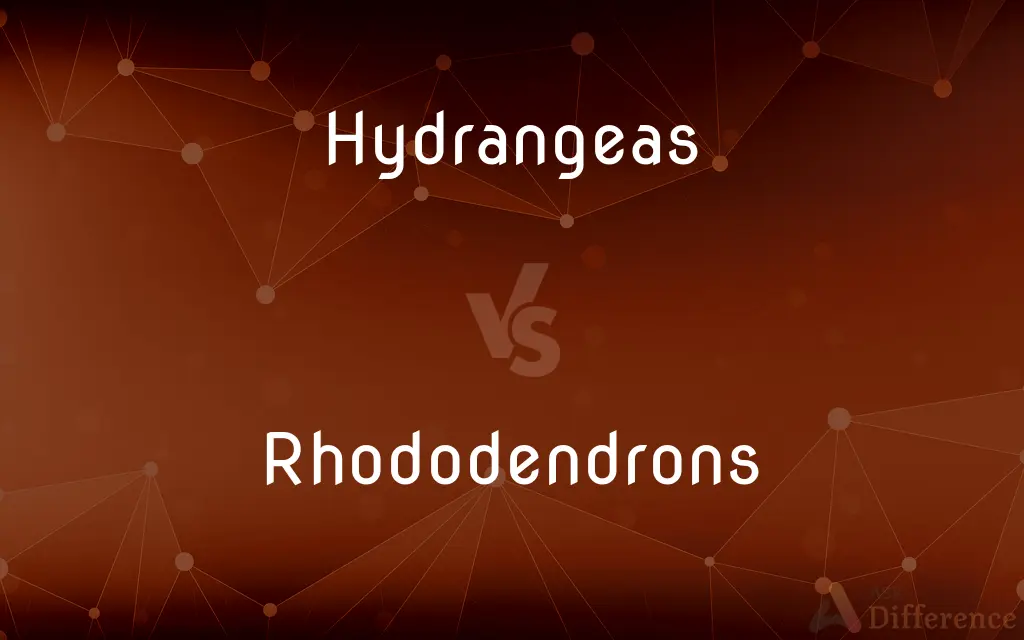Hydrangeas vs. Rhododendrons — What's the Difference?
By Tayyaba Rehman — Published on December 4, 2023
Hydrangeas are flowering shrubs with globe-like clusters, while Rhododendrons are larger shrubs/trees with bell-shaped flowers.

Difference Between Hydrangeas and Rhododendrons
Table of Contents
ADVERTISEMENT
Key Differences
Hydrangeas and Rhododendrons are both popular ornamental plants with captivating flowers. While Hydrangeas are known for their large, round clusters of flowers that can change color based on soil pH, Rhododendrons stand out with their bold, often bell-shaped blossoms.
In terms of growth, Hydrangeas are generally smaller shrubs that can fit into various garden sizes. In contrast, Rhododendrons can range from small shrubs to large trees, making them a more dominant presence in landscapes.
One fascinating feature of Hydrangeas is their color-changing ability. The pH level of the soil influences whether the Hydrangea blooms are blue or pink. Rhododendrons, however, do not have this characteristic, but they make up for it with a broader range of flower colors.
Adaptability is another differing point. Hydrangeas typically prefer moist, well-draining soils and can tolerate more sun. Rhododendrons, on the other hand, thrive in slightly acidic soils and generally prefer partial shade environments.
For garden enthusiasts, both Hydrangeas and Rhododendrons offer seasonal interest. While Hydrangeas bloom mainly in summer, Rhododendrons can provide flowers from late winter to early summer, depending on the species and location.
ADVERTISEMENT
Comparison Chart
Flower Shape
Globe-like clusters
Bell-shaped flowers
Size
Typically smaller shrubs
Range from shrubs to large trees
Soil pH Impact
Can change flower color
No effect on flower color
Preferred Environment
More sun tolerant, moist soils
Partial shade, slightly acidic soils
Blooming Season
Mainly summer
Late winter to early summer
Compare with Definitions
Hydrangeas
Plants whose flower color can change based on soil pH.
By adjusting the soil, she turned her Hydrangeas from pink to blue.
Rhododendrons
Flowers in various colors from late winter to early summer.
By spring, the Rhododendrons were in full bloom.
Hydrangeas
Typically bloom in summer.
Hydrangeas are at their peak during the warm months.
Rhododendrons
A genus of woody plants with bell-shaped flowers.
The mountain was covered in wild Rhododendrons.
Hydrangeas
A flowering shrub known for round flower clusters.
The blue Hydrangeas added a touch of color to her garden.
Rhododendrons
Can range in size from small shrubs to large trees.
The towering Rhododendrons shaded the pathway.
Hydrangeas
Leaves are usually broad and oval.
The Hydrangeas' leaves turned a lovely shade in autumn.
Rhododendrons
Prefer slightly acidic soils.
Rhododendrons thrive in the acidic soils of the woodland.
Hydrangeas
Native to Asia and the Americas.
Many Hydrangeas in American gardens are Asian varieties.
Rhododendrons
Often evergreen with leathery leaves.
Even in winter, the Rhododendrons kept their green foliage.
Hydrangeas
Any of various shrubs of the genus Hydrangea, having opposite leaves and large, flat-topped or rounded clusters of white, pink, or blue flowers.
Rhododendrons
Any of numerous usually evergreen shrubs of the genus Rhododendron of the heath family, having clusters of variously colored, often bell-shaped flowers and widely grown as ornamentals.
Hydrangeas
Plural of hydrangea
Rhododendrons
Plural of rhododendron
Common Curiosities
Why are my Hydrangeas not changing color?
Flower color in Hydrangeas is influenced by soil pH; you might need to adjust it.
Can I plant Rhododendrons in full sun?
Generally, Rhododendrons prefer partial shade, but there are sun-tolerant varieties.
How often should I water Hydrangeas?
Hydrangeas prefer moist soil, so regular watering is beneficial, but avoid over-saturation.
Are Rhododendrons evergreen?
Many Rhododendrons are evergreen, but some species do lose their leaves in winter.
What's the best time to prune Hydrangeas?
It's best to prune Hydrangeas in late winter or early spring.
Do both Hydrangeas and Rhododendrons come in different colors?
Yes, while Hydrangeas can be blue or pink based on soil pH, Rhododendrons come in a variety of colors naturally.
Can Rhododendrons grow in alkaline soil?
Rhododendrons typically prefer slightly acidic soils.
How large can Rhododendrons get?
Depending on the species, Rhododendrons can be small shrubs or grow into large trees.
Can I grow Hydrangeas in pots?
Yes, Hydrangeas can be grown in pots with proper drainage and care.
Do Rhododendrons attract pollinators?
Yes, Rhododendrons attract various pollinators, including bees and butterflies.
Are all Hydrangeas sensitive to soil pH?
Not all, but certain species like Hydrangea macrophylla change color based on soil pH.
Share Your Discovery

Previous Comparison
Costing vs. Cost Accounting
Next Comparison
Autonomous Items vs. Accommodating ItemsAuthor Spotlight
Written by
Tayyaba RehmanTayyaba Rehman is a distinguished writer, currently serving as a primary contributor to askdifference.com. As a researcher in semantics and etymology, Tayyaba's passion for the complexity of languages and their distinctions has found a perfect home on the platform. Tayyaba delves into the intricacies of language, distinguishing between commonly confused words and phrases, thereby providing clarity for readers worldwide.
















































